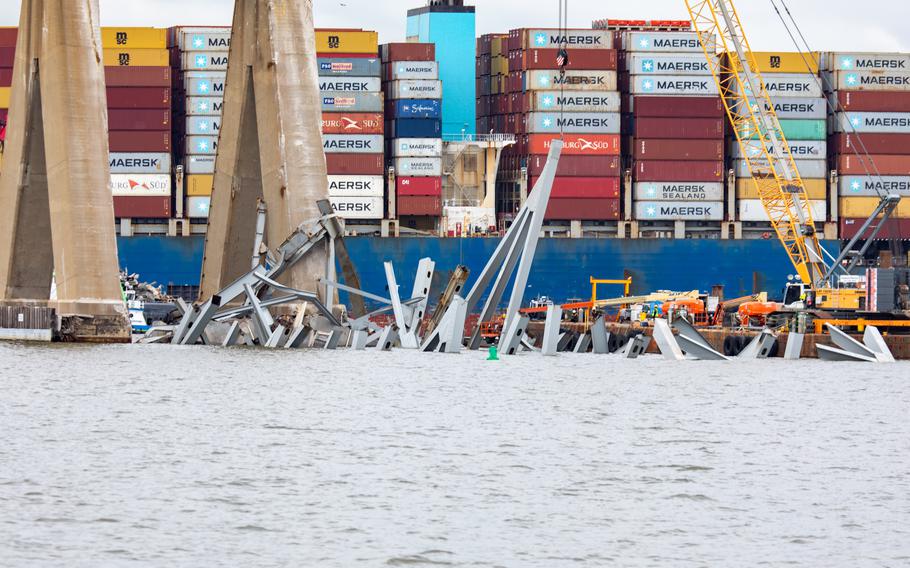
Salvors with the Unified Command continue wreckage removal from the surrounding area of the Dali on May 6, 2024. (Christopher Rosario/U.S. Army Corps of Engineers)
The Dali, the huge container ship that collapsed Baltimore’s Francis Scott Key Bridge in March, closing Baltimore Harbor, will be refloated and moved Monday, a significant milestone in the cleanup of the wreckage, authorities said.
The unified command in charge of operations at the site of the collapse said officials hope to move the vessel at high tide Monday morning to a marine terminal about 2 1/2 miles from where it struck a bridge pier, causing the collapse.
Refloating and removing the Dali appears to be one of the last and largest steps in the eight-week effort to reopen the harbor and its shipping channel after the collapse on March 26.
Maryland Gov. Wes Moore (D) that the Dali will be removed “within days” and the federal channel will be reopened “by the end of May,” despite initial estimates that it might require six to nine months, he said in an interview Sunday on NBC’s “Meet the Press.”
Asked about Republicans who didn’t support allocating federal funds to rebuild the bridge, Moore said it was imperative to keep the project on time and on budget but assured critics, “The American people will be made whole.”
The collapse, with the Dali resting in the shipping channel, has severely affected the Port of Baltimore, and the economy that depends on it, unified command officials said in a statement Saturday.
Six people who were working on the bridge when it collapsed died in the incident. The bodies of all six have been recovered from the Patapsco River as of earlier this month when the remains of a construction worker were recovered.
In a key recent step that made it possible to refloat the Dali, controlled explosions were used to remove a large part of the bridge truss from the bow of the vessel.
Noting that the time of the refloat and the movement of the ship remains subject to change, officials said that as many as five tugboats will escort the Dali to the Seagirt Marine Terminal.
An 18-hour sequence of steps leading to the refloat of the Dali began Sunday, officials said.
Among steps were:
• Releasing some anchors and mooring lines that have been attached to the ship.
• Discharging some or all of the 1.25 million gallons of water pumped aboard the ship to make up for the weight removed by the demolition.
• Inspection to ensure that obstructions have been removed from the left side of the vessel.
Unified command officials have said they evaluated sonar imagery but were also relying on the results of a dive survey before proceeding with plans to refloat and move Dali.
Officials asserted that emphasis will be placed on safety. The tugs are to push or pull the Dali at a speed of about one mile an hour. That is slower than the average walking pace.
Before the controlled demolition of the bridge wreckage, nearly half of the harbor’s main channel had been cleared to a depth of 48 feet, officials said.
They said they expected that in the coming week, the channel would be available to a depth of 50 feet to all commercial vessels going in and out of the Port of Baltimore.
Maryland officials estimate rebuilding the bridge, which opened in 1977, will cost between $1.7 billion and $1.9 billion.
The new bridge will be designed according to modern safety standards intended to prevent it from collapse if a single component fails, officials have said.
Jenna Portnoy and Nitasha Tiku contributed to this report.